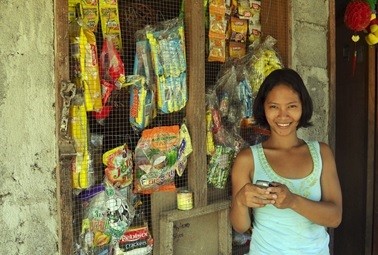
July 2014—Maylene Reyes, 21, is a mother and full-time micro-entrepreneur. She lives in the rural town of Benito Soliven in the Philippines’ Isabela province. She runs a sari-sari store—a convenience store that sells a variety of goods that serve the daily needs of her community. Sari-sari stores are typically operated inside the storeowner’s home and are found in most neighborhoods in the Philippines. In the afternoon, Reyes travels around her village selling banana que, a Filipino snack made of fried bananas coated in caramelized sugar.
She started her sari-sari store business four years ago. In one day, she earns about $11 (500 Philippine pesos) from the store and close to $17 selling banana que. While most of her earnings are spent on household expenses, Reyes wants to put aside money for savings.
“I want to save money so that I have funds to use when my son starts going to school,” explains Reyes. “I also want to add more products to sell in my store.”
She admits that money kept at home is easily spent, so she would like to save the money in a bank account. However, the nearest bank, the First Isabela Cooperative (FICO) Bank, is 27 kilometers away and it costs more than $2 for the two-hour round trip. Just like Reyes, many Filipinos living in rural pockets of the country face this dilemma. Lengthy, costly trips to banks make accessing financial services inconvenient—and sometimes impossible.
However, Reyes has a tool that she can readily use to fulfill her dream of saving money—a mobile phone.
Central Bank of Philippines data show that 37 percent of cities and municipalities in the Philippines do not have a banking office. Financial services are mostly concentrated in high-income urban areas, leaving low-income and far-flung rural areas underserved.
On the other hand, 86 million Filipinos, or more than 75 percent of the population, own a mobile phone. Recognizing this as an opportunity to reach underserved Filipinos, USAID partnered with FICO Bank in late 2013 to encourage healthy financial habits and help mothers achieve their financial goals.
FICO developed a new product called Wais na Nanay Savers Club, or Smart Mothers Savers Club, a program that promotes financial literacy and savings with a mobile phone. The product was launched early this year at the FICO Bank’s head office in Cauayan City, in partnership with USAID’s Scaling Innovations in Mobile Money Project and mobile money provider Globe-Xchange Inc. for the GCash platform.
Reyes is now an active participant. “Now I can deposit $4.50 to my GCash account weekly. This is convenient, as I can make small deposits anytime I want without having to spend time and money going to the bank,” she says.
Apart from FICO Bank, USAID sealed partnerships with some of the country’s biggest microfinance institutions such as the National Confederation of Cooperatives and CCT Savings and Credit Cooperative to promote and broaden mobile money usage to microfinance clients.
Mobile money is now positively reshaping the financial behavior of mothers like Reyes. A GCash agent in Reyes’ town conducted more than $2,200 worth of transactions from 37 members in just two months. Since then, FICO Bank is planning to roll out this digital financial services to its 27 branches. As of June 2014, more than 42,000 individuals opened a savings account via branchless banking initiated with technical assistance support from USAID.
Mobile money is proving to be an effective tool to improve lives and expand opportunities for millions of Filipinos living in remote communities. Meanwhile, USAID is using the same technology to help local governments and businesses offer mobile money to collect loan payments and real estate taxes, service payroll and provide other services.
Mobile money is a cornerstone activity that supports the Government of the Philippines’ goal of achieving sustained and inclusive growth through its bilateral Partnership for Growth initiative. To help the country leapfrog its constraints to growth, USAID has strategically included science, technology and innovation in its programming.
USAID also contributes to the priorities of the U.S.-Philippines Science and Technology Agreement signed by former U.S. Secretary of State Hillary Clinton and Philippine Secretary of Foreign Affairs Albert Del Rosario in June 2012. The agreement focuses on strengthening scientific, technological and institutional capabilities and promoting scientific and technological cooperation.
Through these activities, all Filipinos, like Reyes, have the opportunity to improve their lives—and livelihoods—for many years to come.
Links
Follow @USAID_Manila, on Facebook, on Flickr, on YouTube







Comment
Make a general inquiry or suggest an improvement.